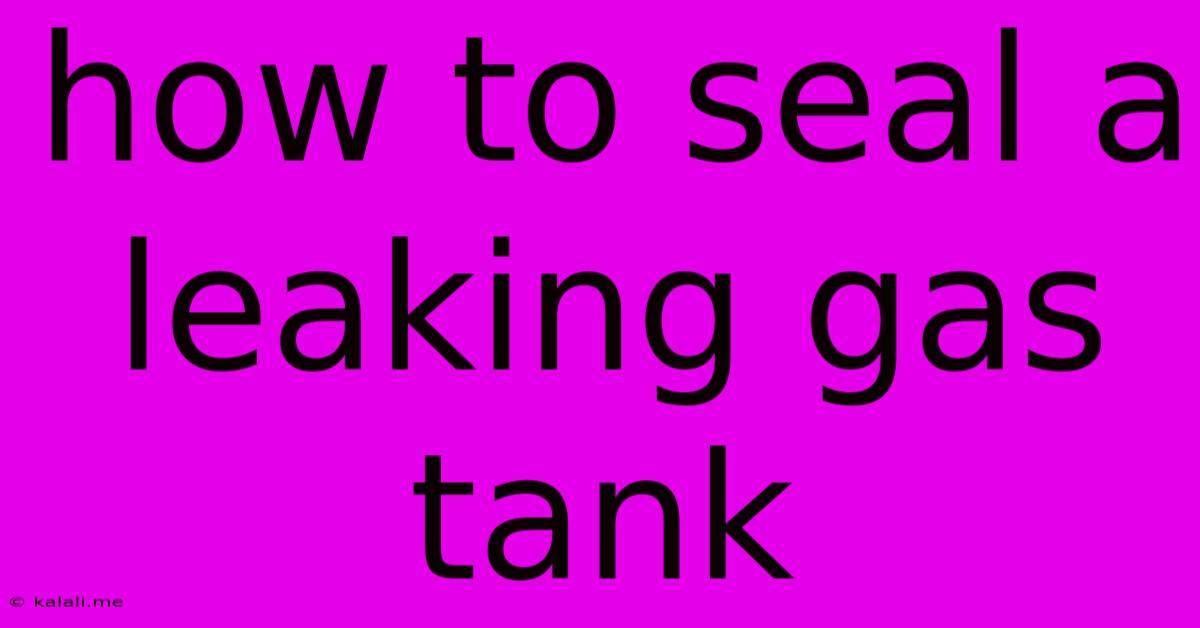How To Seal A Leaking Gas Tank
Kalali
Jun 02, 2025 · 3 min read

Table of Contents
How to Seal a Leaking Gas Tank: A Comprehensive Guide
A leaking gas tank is a serious safety hazard, posing risks of fire, explosion, and environmental damage. Ignoring a leak is never an option. This guide outlines the potential causes, safety precautions, and various methods for sealing a leaking gas tank, helping you address the problem effectively and safely. Remember, always prioritize safety and, if unsure, consult a qualified mechanic.
Identifying the Leak and Assessing the Damage
Before attempting any repairs, locate the leak precisely. This often involves visually inspecting the tank for cracks, rust holes, or loose fittings. Carefully clean the area around the suspected leak to ensure a clear view. A soapy water solution can help pinpoint smaller leaks by creating bubbles where gas escapes. The severity of the leak determines the repair method; small pinhole leaks might be manageable with sealant, while larger holes may require professional attention or tank replacement. The size and location of the leak are crucial in deciding on your approach.
Safety First: Essential Precautions
Working with a leaking gas tank necessitates strict adherence to safety protocols:
- Empty the tank completely: This is paramount. Siphon the remaining fuel into a proper container, ensuring proper ventilation and avoiding sparks or flames.
- Ventilate the area: Work in a well-ventilated space, preferably outdoors, away from ignition sources. Gasoline fumes are highly flammable and inhaling them is hazardous.
- Wear protective gear: Use safety glasses, gloves, and a respirator to prevent exposure to gasoline and potential irritants.
- Use non-sparking tools: Avoid using any tools that could create sparks, including metal tools near the tank.
- Never smoke or use open flames: This is crucial to prevent ignition of gasoline vapors.
- Dispose of fuel properly: Follow local regulations for the safe disposal of gasoline.
Methods for Sealing a Leaking Gas Tank
Several methods can be employed depending on the size and location of the leak:
1. Gas Tank Sealant:
This is suitable for minor leaks, typically pinhole-sized cracks or small rust holes. These sealants are designed to adhere to metal and create a waterproof seal.
- Surface Preparation: Clean and dry the area thoroughly before applying the sealant. Any rust or loose debris needs to be removed for proper adhesion.
- Sealant Application: Follow the manufacturer's instructions meticulously. Many sealants require multiple applications for optimal effectiveness. Allow ample drying time.
- Testing: After the sealant has fully cured, test for leaks using the soapy water method.
2. Epoxy Resin:
For slightly larger holes or cracks, a strong two-part epoxy resin can provide a durable seal. The epoxy needs to be properly mixed according to the manufacturer's instructions for a strong bond.
- Preparation: Thoroughly clean, dry, and prepare the area as with gas tank sealants. You might need to use a wire brush to remove rust or loose metal.
- Application and Curing: Apply the mixed epoxy carefully, ensuring it fills the hole completely. Allow ample curing time. The curing time varies depending on the type of epoxy used.
- Testing: After the epoxy has cured, test for leaks.
3. Professional Repair or Replacement:
If the leak is substantial, involves significant damage, or you are uncomfortable performing the repair yourself, seek professional assistance. A qualified mechanic can assess the damage, determine the best course of action, and may recommend welding, patching, or even replacing the gas tank. This is often the safest and most reliable solution for extensive damage.
Preventing Future Leaks
Regular maintenance can help prevent future gas tank leaks:
- Regular Inspections: Periodically inspect your gas tank for signs of rust, damage, or leaks.
- Proper Fuel Handling: Avoid overfilling the tank, which can cause fuel spillage and potential damage.
- Corrosion Prevention: Apply a rust-preventative coating to protect the tank from corrosion.
- Professional Maintenance: Schedule regular vehicle maintenance checks to identify potential problems early.
Addressing a leaking gas tank is a serious matter requiring careful attention to safety. By following these steps and understanding your options, you can effectively address the problem and prevent potential hazards. Remember, safety should always be your top priority. If in doubt, always consult a qualified mechanic.
Latest Posts
Latest Posts
-
What Time To Feed Outside Stray Catrs
Jun 04, 2025
-
How To Say Link In Spanish
Jun 04, 2025
-
Cult Of The Lamb Map Symbols
Jun 04, 2025
-
To Do Or Not To Do
Jun 04, 2025
-
Fallout 4 Powering Up Reconfigure The Transmitter
Jun 04, 2025
Related Post
Thank you for visiting our website which covers about How To Seal A Leaking Gas Tank . We hope the information provided has been useful to you. Feel free to contact us if you have any questions or need further assistance. See you next time and don't miss to bookmark.